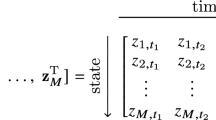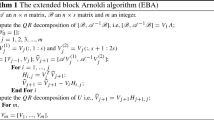Abstract
We develop a randomized Newton’s method for solving differential equations, based on a fully connected neural network discretization. In particular, the randomized Newton’s method randomly chooses equations from the overdetermined nonlinear system resulting from the neural network discretization and solves the nonlinear system adaptively. We theoretically prove that the randomized Newton’s method has a quadratic convergence locally. We also apply this new method to various numerical examples, from one to high-dimensional differential equations, to verify its feasibility and efficiency. Moreover, the randomized Newton’s method can allow the neural network to “learn” multiple solutions for nonlinear systems of differential equations, such as pattern formation problems, and provides an alternative way to study the solution structure of nonlinear differential equations overall.











Similar content being viewed by others
Data availability
Data sharing not applicable to this article as no datasets were generated or analysed during the current study.
References
Ames, W.F.: Nonlinear partial differential equations in engineering, vol. 18. Academic press (1965)
Baranyi, J., Roberts, T.A., McClure, P.: A non-autonomous differential equation to model bacterial growth. Food Microbiol. 10(1), 43–59 (1993)
Bramble, J.H., Pasciak, J.E., Wang, J., Xu, J.: Convergence estimates for multigrid algorithms without regularity assumptions. Math. Comput. 57(195), 23–45 (1991)
Bungartz, Hans-Joachim., Griebel, Michael: Sparse grids. Acta Numer 13, 147–269 (2004)
Chen, J., Lopes, M.: Estimating the error of randomized newton methods: A bootstrap approach. In: International Conference on Machine Learning, pp. 1649–1659. PMLR (2020)
Chou, C., Shu, C.: High order residual distribution conservative finite difference weno schemes for steady state problems on non-smooth meshes. J. Comput. Phys. 214(2), 698–724 (2006)
Chou, C., Shu, C.: High order residual distribution conservative finite difference weno schemes for convection-diffusion steady state problems on non-smooth meshes. J. Comput. Phys. 224(2), 992–1020 (2007)
Courant, R., Hilbert, D.: Methods of Mathematical Physics: Partial Differential Equations. John Wiley & Sons (2008)
Cybenko, G.: Approximation by superpositions of a sigmoidal function. Math. Control Signals Systems 2(4), 303–314 (1989)
De Lellis, C., Otto, F., Westdickenberg, M.: Minimal entropy conditions for burgers equation. Q. Appl. Math. 62(4), 687–700 (2004)
Della-Dora, J.: Numerical linear algorithms and group theory. Linear Algebra Appl. 10(3), 267–283 (1975)
Han, W.E.J., Jentzen, A.: Deep learning-based numerical methods for high-dimensional parabolic partial differential equations and backward stochastic differential equations. Communications in Mathematics and Statistics 5(4), 349–380 (2017)
Evans, L.C.: Partial Differential Equations. Graduate studies in mathematics. American Mathematical Society (2010)
Farrell, P.E., Birkisson, A., Funke, S.W.: Deflation techniques for finding distinct solutions of nonlinear partial differential equations. SIAM J. Sci. Comput. 37(4), A2026–A2045 (2015)
Fedosov, D.A., Lei, H., Caswell, B., Suresh, S., Karniadakis, G.E.: Multiscale modeling of red blood cell mechanics and blood flow in malaria. PLoS Comput. Biol. 7(12), e1002270 (2011)
Forsyth, D.A., Ponce, J.: Computer vision: a modern approach. Prentice Hall Professional Technical Reference (2002)
Gierer, A., Meinhardt, H.: A theory of biological pattern formation. Kybernetik 12(1), 30–39 (1972)
Hao, W., Hauenstein, J.D., Hu, B., Sommese, A.J.: A bootstrapping approach for computing multiple solutions of differential equations. J. Comput. Appl. Math. 258, 181–190 (2014)
Hao, W., Hauenstein, J.D., Shu, C., Sommese, A.J., Xu, Z., Zhang, Y.: A homotopy method based on weno schemes for solving steady state problems of hyperbolic conservation laws. J. Comput. Phys. 250, 332–346 (2013)
He, J., Li, L., Xu, J., Zheng, C.: Relu deep neural networks and linear finite elements. arXiv preprint arXiv:1807.03973 (2018)
Hu, B.: Blow-up theories for semilinear parabolic equations. Springer (2011)
Karniadakis, G., Sherwin, S.: Spectral/hp element methods for computational fluid dynamics. Oxford University Press (2013)
Kloeden, P.E., Platen, E.: Numerical solution of stochastic differential equations, vol. 23. Springer Science & Business Media (2013)
Kondo, S., Miura, T.: Reaction-diffusion model as a framework for understanding biological pattern formation. Science 329(5999), 1616–1620 (2010)
Lee, K.J., McCormick, W.D., Ouyang, Q., Swinney, H.L.: Pattern formation by interacting chemical fronts. Science 261(5118), 192–194 (1993)
Lei, H., Karniadakis, G.E.: Quantifying the rheological and hemodynamic characteristics of sickle cell anemia. Biophys. J . 102(2), 185–194 (2012)
Leykin, A.: Numerical algebraic geometry. Journal of Software for Algebra and Geometry 3(1), 5–10 (2011)
Li, Q., Tai, C., W.E.: Stochastic modified equations and adaptive stochastic gradient algorithms. In: Proceedings of the 34th International Conference on Machine Learning-Volume 70, pages 2101–2110. JMLR. org (2017)
Liu, Y., Cheng, Y., Chen, S., Zhang, Y.: Krylov implicit integration factor discontinuous galerkin methods on sparse grids for high dimensional reaction-diffusion equations. J. Comput. Phys. 388, 90–102 (2019)
Maini, P.K., Woolley, T.E., Baker, R.E., Gaffney, E.A., Lee, S.S.: Turing’s model for biological pattern formation and the robustness problem. Interface focus 2(4), 487–496 (2012)
Manning, C.D., Schütze, H.: Foundations of statistical natural language processing. MIT press (1999)
Marion, M., Xu, J.: Error estimates on a new nonlinear galerkin method based on two-grid finite elements. SIAM J. Numer. Anal. 32(4), 1170–1184 (1995)
Medler, D.A., Dawson, M.R.W.: Training redundant artificial neural networks: Imposing biology on technology. Psychol. Res. 57(1), 54–62 (1994)
Medler, D.A., Dawson, M.R.W.: Using redundancy to improve the performance of artificial neural networks. In: Proceedings of the Biennial Conference-Canadian Society for Computational Studies of Intelligence, pages 131–138. CANADIAN INFORMATION PROCESSING SOCIETY (1994)
Nobile, F., Tempone, R., Webster, C.G.: A sparse grid stochastic collocation method for partial differential equations with random input data. SIAM J. Numer. Anal. 46(5), 2309–2345 (2008)
Nocedal, J., Yuan, Y.: Combining trust region and line search techniques. In: Advances in nonlinear programming, pages 153–175. Springer (1998)
Paidoussis, M.P.: Fluid-structure interactions: slender structures and axial flow, vol. 1. Academic press (1998)
Pearson, J.E.: Complex patterns in a simple system. Science 261(5118), 189–192 (1993)
Pilanci, M., Wainwright, M.: Newton sketch: A near linear-time optimization algorithm with linear-quadratic convergence. SIAM J. Optim. 27(1), 205–245 (2017)
Piscopo, M.L., Spannowsky, M., Waite, P.: Solving differential equations with neural networks: Applications to the calculation of cosmological phase transitions. Phys. Rev. D 100, 016002 (2019)
Qin, T., Wu, K., Xiu, D.: Data driven governing equations approximation using deep neural networks. J. Comput. Phys. 395, 620–635 (2019)
Russell, R.D., Shampine, L.F.: A collocation method for boundary value problems. Numer. Math. 19(1), 1–28 (1972)
Schumack, M.R., Schultz, W.W., Boyd, J.P.: Spectral method solution of the stokes equations on nonstaggered grids. J. Comput. Phys. 94(1), 30–58 (1991)
Shen, J., Tang, T., Wang, L.: Spectral methods: algorithms, analysis and applications, vol. 41. Springer Science & Business Media (2011)
Shen, J., Yu, H.: Efficient spectral sparse grid methods and applications to high-dimensional elliptic problems. SIAM J. Sci. Comput. 32(6), 3228–3250 (2010)
Shu, C.: High-order finite difference and finite volume weno schemes and discontinuous galerkin methods for cfd. International Journal of Computational Fluid Dynamics 17(2), 107–118 (2003)
Siegel, Jonathan W., Xu, Jinchao: High-order approximation rates for neural networks with \(\operatorname{ReLU}^k\) activation functions. arXiv preprint arXiv:2012.07205 (2020)
Sirignano, J., Spiliopoulos, K.: Dgm: A deep learning algorithm for solving partial differential equations. J. Comput. Phys. 375, 1339–1364 (2018)
Smith, Barry, Bjorstad, Petter, Gropp, William: Domain decomposition: parallel multilevel methods for elliptic partial differential equations. Cambridge University Press (2004)
Sommese, A.J., Verschelde, J., Wampler, C.W.: Introduction to numerical algebraic geometry. In: Solving polynomial equations, pages 301–337. Springer (2005)
Toselli, A., Widlund, O.: Domain decomposition methods-algorithms and theory, vol. 34. Springer Science & Business Media (2006)
Turing, A.M.: The chemical basis of morphogenesis. Bull. Math. Biol. 52(1–2), 153–197 (1990)
Wampler, C.W., Sommese, A.J.: Numerical algebraic geometry and algebraic kinematics. Acta Numer 20, 469–567 (2011)
Wang, Y., Hao, W., Lin, G.: Two-level spectral methods for nonlinear elliptic equations with multiple solutions. SIAM J. Sci. Comput. 40(4), B1180–B1205 (2018)
Wang, Y., Lin, G.: Efficient deep learning techniques for multiphase flow simulation in heterogeneous porous media. Journal of Computational Physics, page 108968 (2019)
Weickert, J., Schnörr, C.: A theoretical framework for convex regularizers in pde-based computation of image motion. Int. J. Comput. Vision 45(3), 245–264 (2001)
Wu, K., Xiu, D.: Data-driven deep learning of partial differential equations in modal space. arXiv preprint arXiv:1910.06948 (2019)
Xing, Y., Shu, C.: High order finite difference weno schemes with the exact conservation property for the shallow water equations. J. Comput. Phys. 208(1), 206–227 (2005)
Xiu, D.: Numerical methods for stochastic computations: a spectral method approach. Princeton University Press (2010)
Xu, J., Zikatanov, L.: A monotone finite element scheme for convection-diffusion equations. Mathematics of Computation of the American Mathematical Society 68(228), 1429–1446 (1999)
Xu, J., Zikatanov, L.: On an energy minimizing basis for algebraic multigrid methods. Comput. Vis. Sci. 7(3–4), 121–127 (2004)
Xu, Jinchao: The finite neuron method and convergence analysis. arXiv preprint arXiv:2010.01458 (2020)
Funding
The authors have not disclosed any funding.
Author information
Authors and Affiliations
Corresponding author
Ethics declarations
Conflict of interest
This research is supported by NSF via DMS-1818769. There is no conflict of interest.
Additional information
Publisher's Note
Springer Nature remains neutral with regard to jurisdictional claims in published maps and institutional affiliations.
Rights and permissions
About this article
Cite this article
Chen, Q., Hao, W. Randomized Newton’s Method for Solving Differential Equations Based on the Neural Network Discretization. J Sci Comput 92, 49 (2022). https://doi.org/10.1007/s10915-022-01905-9
Received:
Revised:
Accepted:
Published:
DOI: https://doi.org/10.1007/s10915-022-01905-9




